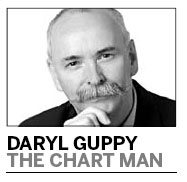Investment
Playing safe in tricky October
By Daryl Guppy (China Daily)
Updated: 2010-09-13 08:30
 |
Large Medium Small |

Investment success can depend upon catching the right idea at the right time, or by acting boldly when others are cowering in fear. October in the markets provides an opportunity to put one of these approaches to the test. Many people feel that October is the worst month in the markets.
This feeling is confirmed by the US market crashes in October 1987, October 1997 and, more recently and painfully, in October 2008. Those people with longer memories point to the 1929 crash in October. A very casual inspection of the Dow Index chart suggests that October is a month to avoid as market volatility on the downside increases. For the bold traders, October is a month of opportunity. There are two factors at play here. The first is the market behavior in October. The second is the changes to these behaviors that have developed in recent years. Ask someone on main street and they will tell you October is the worst month in the market. They are correct. October delivers some substantial falls from peak to bottom. These include 1987 and 2008. What happens after the bottom is touched is where the opportunity lies. These rapid declines are followed by equally rapid rises. On average October is a rising month. The closing value of the index at the end of October is usually higher than the October opening value on the index. The ride between these two values is fast, terrifying and profitable.
October has an increase in volatility, but it is not automatically a bearish month. Traders, and investors, who act boldly when others are frightened by the October trick-or-treat market find they are rewarded with a treat. In many markets the October recovery is the beginning of a longer market rise into Christmas and sometimes January.
A closer inspection of the Dow index price chart shows a different relationship. It's the gap between perception and reality that offers the largest profit opportunities. In recent years an interesting change has developed on the way to October. The downside volatility has moved further back in time. These volatility shakeouts have begun to appear in September. The Dow retreat in 2001 and 2002 were delivered in September or, in 1998, in August. Investors who entered the market after these retreats were rewarded with rapidly rising October and a prolonged uptrend lasting several months.
This is a result of human nature and it is the aggregation of individual human nature that creates the behavior which propels markets. People believe in the potential for an October market collapse. Many sell stocks as a preventative measure in September, hoping to buy the stock back at lower prices after the market retreat in October. Many are frightened by the current discussion of a double-dip and other signs of economic weakness. They sell because they want to avoid a repeat of the 2008 market massacre. Taken together, all this September selling creates increasing downside pressure in the market.
When markets are nervous because they anticipate bad news then they react rapidly to any bad news. It is like a horror movie where the audience is primed for fear. They are ready to jump in fright at the smallest noise. The fear of October has transferred into selling activity in September and this in turn has shifted the downside October volatility into the last weeks of September.
October offered opportunities for the brave. Now September offers these opportunities. Many traders are already protecting and collecting profits from open trades. They have cash in reserve, ready to short the market if the market tumbles in the next two to six weeks. They are alert for shorting opportunities and they are also alert for bullish trading opportunities.
These traders are ready to cover their short sales and move quickly to the long side of the market as the extremes of the price dip are achieved. This is a trade based on observed and repeated human behavior in October. People expect a market fall and then, once its has occurred, they are happy to buy again. The smarter traders join this rebound in confidence and trade the October rally that almost inevitably follows the October crash.
Markets are creatures of habit because market participants yield to the same behavioral pressures as the man in the street. The people trading in the funds and institutions are, at heart, not much different, or smarter, when it comes to fear and greed. It takes a particular form of financial courage to act boldly when the market is falling but get the timing right and this is a real October treat. For most years neither September nor October are more volatile, or have more falls, than any other month in the year.
The author is a well-known international financial technical analysis expert.